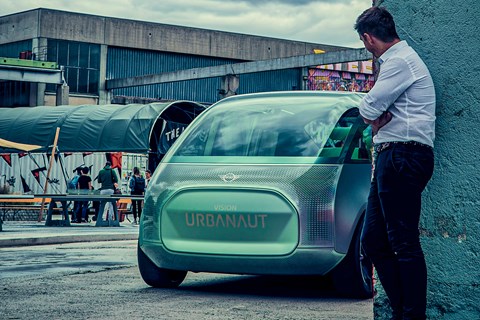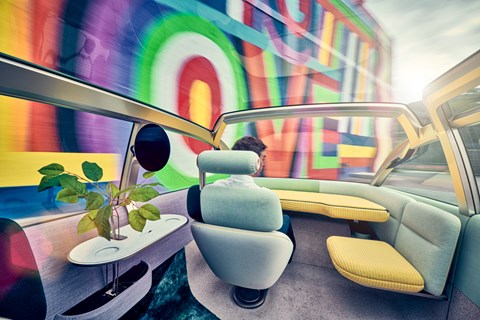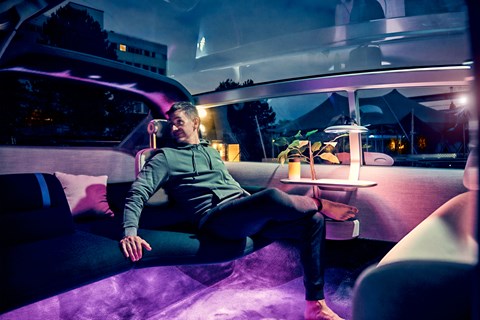► Living in the Mini Urbanaut concept
► How Mini really is going big…
► …and out to prove the MPV isn’t dead
This content was part of CAR magazine’s 60th anniversary celebrations, split over three editions. Want to read more from those editions, as well as get access to more amazing content from CAR? Become a member here with a 99p trial!
Mid-afternoon and I’m starting to zone out. It’s warm, and my eyes are growing heavy as woozy sunshine bathes the Mini’s extensive overhead glazing. The rhythmic whoosh, clank and giggle of the skateboarders nearby grows quieter, fusing with the squeaks and shouts from the basketball court and the blissed-out beats from the bar into a soporific background noise of urban summer contentment.
Reclined in a space more studio loft than car, the Urbanaut’s daybed looks tempting. I can’t blame driving fatigue: the self-driving Mini’s been doing the heavy lifting there. Must be the early start and the weather. It’s a perfect July afternoon in Munich, the heat rendered pleasant rather than punishing by a breeze that plays through the open side-door and front screen.
Evidently living in the future – both of Mini and perhaps of the car itself – is a deeply relaxing experience.
A car for the WFH age
If the pandemic’s been a sort of black hole into which the best part of two years simply vanished, Mini’s electric, autonomous Urbanaut concept (originally unveiled in 2020) somehow escaped chronological oblivion. If anything, the study – a kind of proto-ID. Buzz, and an impossibly cool reinterpretation of the proclaimed-dead MPV – only became more relevant as traditional workplaces, working practices and office hours were abandoned, literally overnight, in favour of something more flexible, more enjoyable, more human. And if we’re now free to work from anywhere, a versatile and spacious Mini with the potential for a different view every day is not without appeal.

‘It’s a concept, right?’ asks 18-year-old Moritz Dunbar through the open door, skateboard in hand. ‘I like it a lot as a piece of design. I’m still at school and I drive a V70 Volvo… I’m looking to study concept art or maybe music production. I really like the idea of a space you can take anywhere, but in reality I think you’ll have to drive it yourself. Self-driving cars still feel like a long way off.’
Nearby, Thomas Kirchenmajer watches his six-year-old son get to grips with the bowls, berms and rails of this polished concrete utopia. ‘I can’t imagine he’ll do a driving test or own a car. Not so much because cars will drive themselves but because better internet coverage will mean he can work from anywhere. I really like the look of your Mini. I’ve had a few Minis, including one of the first convertibles. Now I have an XC60 Recharge. Electric next I guess.’
I can hear my email inbox growing exponentially, so I grab my laptop and head back to the Mini. The Urbanaut’s refreshingly non-automotive interior, which eschews black plastic, touchscreens and a conventional dash, relies heavily on a couple of key pieces of technology: a compact electric powertrain powered by an underfloor battery, for an epic amount of interior space in a vehicle less than 4.5 metres long; fly-by-wire steering, for the packaging flexibility such a system brings; and flawless speech recognition, allowing Mini to do away with physical buttons and touchscreens. It’s hardly the stuff of science fiction – Toyota’s bZ4X steers by wire, for example. As ever, it’s the self-driving bit – a conceptual option when the car is in its ‘Wanderlust’ travel mode – that asks you to suspend disbelief.

But the Urbanaut can still be driven. There’s a steering wheel should you want it – a racy-looking cork and fabric oblong that rises from the ‘dash’ when you tap the Mini logo. Time to relocate, not least because I’ve an important guest on his way. The driver’s seat and I turn to face the world ahead, the Mini’s powertrain wakes and, via the two very conspicuous pedals in the otherwise flat and uncluttered floor, we get moving.
Having friends over
The sleekly aerodynamic Urbanaut, with its trademark Mini wheel-at-each-corner stance and instant electric torque, is a giggle to drive, its big blue skateboard-inspired wheels rolling fast and free as we navigate Munich and dream of the Alps not far to the south…
Reality check. The Urbanaut, a concept remember, tops out at walking pace and handles, well, like a static display piece… But, just as its powertrain is no flight of fantasy, so it’s easy to imagine a production Urbanaut being as true as it needs to be to Mini’s dynamic DNA.
With perfect timing Mini’s design boss Oliver Heilmer drops by. He’s all smiles as he sees his baby outside of a motor-show stand or a photographic studio for the first time. In anticipation I’ve had a little tidy-up and watered my plants.

‘Fun-to-drive is always our approach,’ he tells me, somehow looking cool and composed as the sun breaks through the clouds and we begin to gently bake. ‘Even the Urbanaut should have this. But this is not so difficult. You have the wheels at each corner, the wheelbase is around three metres and with electric power you get instant acceleration. Then it’s just a case of how we arrange the suspension and the direct steering for that Mini feel.’
I put it to him that, once you break it down, the Urbanaut is actually pretty feasible. ‘We’d love to have this,’ he smiles.
Conceived back in 2019 as a vessel into which Mini’s team could pour its next-generation design ideas, the project quickly acquired a second, unforeseen importance. It became a test bed for the notion that, so long as Mini stayed true to a few core attributes (space efficiency – the standout genius of Issigonis’ original – and a sense of fun), perhaps the brand could roam far beyond hatches and the awkward but successful Countryman.
As early as the car’s physical debut (at last year’s Munich show) the talk was of a production green light. After the Aceman and a new Countryman, due next year, an Urbanaut-inspired production car on the next BMW X1 platform is, we hear, in the plan.
Isn’t an MPV at odds with the Mini that started it all, and that remains the brand’s touchstone?
‘We knew we needed a Mini approach,’ counters Heilmer. ‘And some of the team who’ve known the brand longer than I have told us that honestly, this was within the Mini brand. It happened in ’59, right? Someone did something disruptive with a strong sense of purpose behind it. And if we could not do this – not choose a direction like this – my job would be really boring! But I’m doing this for the brand, not just for myself. This happened with the Countryman. Some customers said, “No, this is not a Mini any more.” But now it’s established. So we can say, “Okay, this is Mini’s bandwidth now. And it’s much bigger than we thought.”

‘I’ve always pushed for the next thing in whatever I’ve done. I don’t have a problem messing with heritage. But I would say the Urbanaut is still true to Mini. It’s a different interpretation of it, and that’s when things get exciting.’
Talking of MPVs, might we go full circle? Could crossovers and SUVs, which killed off cars like the Picasso, Espace and Galaxy, in turn be rendered obsolete by a new generation of more socially-acceptable MPVs? ‘There are two trends,’ explains Heilmer. ‘Right now, crossovers and SUVs are selling more and more. But there’s another trend, too. Our target group is questioning whether having an SUV in the city is the right thing. Maybe by 2030, 2035, the SUV won’t count any more.’
The guided tour
Just as the original Mini turned its engine through 90° and mounted it transversely, liberating the space for four (or more…) within a tiny, affordable and hilariously fun car, so the Urbanaut reconsiders the automotive interior’s ‘essentials’ to deliver camper-van space within a footprint only marginally longer than a Countryman’s.
Heilmer’s boss, Adrian van Hooydonk, approved the concept for further work in September 2019. Development progressed from the inside out, with the Urbanaut being defined initially by a full-sized image of the package’s plan view marked out on the floor.

‘We started with what we needed and nothing else,’ notes Heilmer. ‘We wanted to create these different moments, such as when you’re driving and when you just want to retreat and relax. The daybed came out of realising that, in a normal car, this space [under the windscreen] is always occupied by the steering wheel and the fact that you have to drive. We still wanted that, despite this potentially being a self-driving car. But a dashboard stood in contradiction to the other moments we wanted. Hence the daybed. When you’re not driving it drops down and the steering wheel disappears. Now you can use all this space at the front of the car, especially with the windscreen open – an idea that came from tractors.’
There’s stowage space beneath the daybed (my folding bicycle fits a treat) and a boot, though not in the concept car. Further back, across the cork and semi-carpeted floor, there’s more seating, with a backrest that stows away for a cosier feel.
‘Early on during the project I was driving an electric Mini, travelling through the city, and I parked to plug it in,’ explains Heilmer. ‘Charging took maybe an hour, and you just sit there with the steering wheel thinking, “This is impossible.” I had a laptop and we had Teams, and I began to think about a space like this [motions to the rear of the Urbanaut]. It’s a zone that’s a bit darker, for the computer, thanks to this arc overhead, so you can work while the car is charging. Like this the car is more of an object than a parked car, and we always wanted this connection between inside and outside. It’s not like a cage or a box.’

It really isn’t. As late afternoon gives way to evening, claustrophobia isn’t the issue – hunger is. So I head out for pizza on my bike, taking in a few laps of the skate park as I go. The light’s dropping when I return (it’ll be back at 4am…), the Urbanaut’s endlessly customisable light signatures projecting playful patterns in the balmy night. ‘More than ever, Mini has to be a brand that you love; a brand that is friendly and that lifts your mood,’ Heilmer told me earlier.
The feelgood Urbanaut absolutely does that – though it could use some curtains.